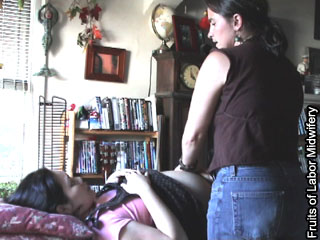Soon after I found out that I was pregnant, I set out to find the health provider who will assist me throughout my pregnancy and deliver my baby. I knew I wanted to have my child at home. Although hospitals are equipped for any possible emergency, I worry about the stress of driving during labor and infection control in institutional settings. I wanted to be in the place where I’m most comfortable.
Midwifery Services
I started by requesting a list of midwives in my locale from the Midwives Alliance of North America. I called a few licensed professional midwives and conducted interviews over the phone.
 Each midwife is different. Some midwives conduct pre-natal visits in their homes or offices so that they can be in a central location in case any of their clients call for labor. Some midwives come to their clients’ homes all the way from pre- to post-natal visits. This situation was the most attractive to me, so I immediately filtered out the ones who were not willing to come to my home for all visits.
Each midwife is different. Some midwives conduct pre-natal visits in their homes or offices so that they can be in a central location in case any of their clients call for labor. Some midwives come to their clients’ homes all the way from pre- to post-natal visits. This situation was the most attractive to me, so I immediately filtered out the ones who were not willing to come to my home for all visits.
HMO insurance does not cover midwifery services. PPO may reimburse part or all of the midwifery expenses. Most midwives charge on a sliding scale between $2800 to $5000 for comprehensive pre-natal visits, labor/delivery and post-partum visits. Each visit generally lasts for about an hour, consisting of monitoring urine, weight, blood pressure, pulse, baby’s heartbeat, palpation of the uterus, nutritional counseling and consultation regarding various issues that arise during pregnancy.
Not all pregnancies qualify for a home birth. Hospital births are recommended in cases of gestational diabetes, hypertension (high blood pressure), Rh negative mom with a positive antibody screen, preterm premature rupture of membranes, multiple gestations (e.g. twins), breech presentation, active genital herpes, preeclampsia and preterm labor.
Most midwives carry the following equipment, supplies and medication during home birth: oxygen, bag and mask for neonatal resuscitation, laryngoscope for neonatal resuscitation, IV therapy equipment, basic anti-hemorrhagic medication, suturing supplies (suture and lidocaine), fetoscope and hand-held Doppler, Rescu-Vac and/or DeLee catheter for deep suction of the newborn if necessary (as in the case with passage of meconium), urinary catheters, vitamin K for newborn blood clotting, and erythromycin ointment for newborn infection prophylaxis.
Most midwives do not carry: pain medication including epidurals or narcotics, surgical equipment beyond that needed for basic suturing, forceps or vacuum, continuous fetal monitoring equipment, and blood for transfusions.
Obstetrics-Gynecology
I come from a medical family, so naturally my parents were very concerned about my decision to have my baby at home with the help of a midwife. As a compromise, I am also seeing a medical doctor, an obstetrician-gynecologist, in case of an emergency.
Gone are the days when doctors made house calls, so obviously one must consider the trip to the doctor’s office for pre-natal visits and the ride to the hospital for labor/delivery when choosing an Ob-Gyn. I chose a doctor who practises very close to where I live, so I could avoid the freeway traffic or long drives during my pregnancy.
HMO insurance generally require a copay for the first visit with the Ob-Gyn, then there is no more copay for the succeeding visits. Each visit is about 10 to 20 minutes long, consisting of monitoring urine, weight, blood pressure, pulse, baby’s heartbeat, palpation of the uterus and some consultation regarding various issues that arise during pregnancy.
During the first visit, the Ob-Gyn may conduct a pap smear and prescribe a blood test. Often, pre-natal visits are attended by a nurse practitioner instead of the Ob-Gyn. There is hardly any consultation regarding nutrition. The most nutrition advice I have gotten from my doctor has been to eat small meals throughout the day instead of the regimented three square meals.
As far as Ob-Gyn’s go, my doctor is better than most. She promises not to jump to C-sections, unless absolutely necessary. She also professes not to do episiotomies. There are less invasive techniques to preserving a woman’s perenium during childbirth. Episiotomies are not only extremely painful, it also takes a woman longer to heal than one who has not been subjected to it.
Case by Case Comparison:
Midwife vs. Obstetrician-Gynecologist
Pre-natal Vitamins. The Ob-Gyn prescribed Natal Care Plus, which are large pink-colored pills that made me feel nauseous whenever I took them. I worried about the additives from the manufacturing process of these commercial pills. Later on I read in this article about Zinc, which states that Zinc supplements should not be taken with Iron and Calcium. So why are these three minerals together in prenatal vitamin pills?
My midwife suggested that I make herbal tea for vitamin supplementation instead. She recommended: 1/4 cup nettles, 1/4 cup red raspberry leaves, 16 oz water combined in a glass jar. Cover and let it sit overnight. Sip this cold herbal infusion throughout the next day. Apparently nettles is rich in iron and calcium. Red raspberry leaves are rich in vitamins and minerals, particularly iron, in addition to being a uterine tonic.
The cold herbal infusion was difficult for me to get down. So I added honey and/or lemon to the tea, and refrigerated it to make it taste more like iced tea. Steeping it hot like regular tea also helps with the taste.
Urinary Tract Infection. My first blood test revealed a bladder infection, so my Ob-Gyn immediately put me on Nitrofurantoin. Kudos to the doctor for her diagnosis. It made me really glad that I have a medical doctor overseeing my care. However I was hesitant to take antibiotics, knowing how much they can wreak havoc in my system.
I consulted my midwife and she said that since I hadn’t been abusing antibiotics in any way pre-pregnancy (4 years earlier was the last time I’ve had any in my system) she was confident that this dose will take care of my problem quickly, without any concern for resistant bacteria. She also suggested:
- Echinacea and Goldenseal – the kind that contains ONLY echinacea and goldenseal. Don’t take the chance with other herbal ingredients that could complicate things for pregnant women;
- Vitamin C – no more than 500 mg a day;
- Cranberry juice – contains substances that inhibit the growth of bacteria in the bladder. Remember to buy UNSWEETENED cranberry juice. Refined sugars foster the growth of bacteria, and will be defeating the whole purpose of drinking cranberry juice.
- Water – drink 2 liters (equivalent to 64 oz. = 8 pint-size glasses) a day.
When I consulted my nurse practitioner about my fears of complications arising from the use of antibiotics, such as yeast infections, the only recommendation she had was anti-fungal cream over the counter at the
drug store. In comparison, my midwife had suggestions on how to prevent yeast infections through good nutrition (plain yogurt).
Sciatica. In the case of sciatica, my midwife recommended the relatively invasive approach of acupuncture, while my doctor simply suggested taking a hot bath.
Related Links:
Baby Center
Pregnancy Nutrition
Pregnancy Myths
Herbs for Pregnancy
Herbs During Pregnancy
Citizens for Midwifery
Midwives Alliance of North America
Midwife Info
Midwifery Links
Ob-Gyn Predicament
Unassisted Childbirth
Unhindered Childbirth
 My husband and I run our internet business from home, and are both able to raise our baby full time. My husband made this animation while I was still pregnant, and he was still only imagining his life as a full time father.
My husband and I run our internet business from home, and are both able to raise our baby full time. My husband made this animation while I was still pregnant, and he was still only imagining his life as a full time father.






 Each midwife is different. Some midwives conduct pre-natal visits in their homes or offices so that they can be in a central location in case any of their clients call for labor. Some midwives come to their clients’ homes all the way from pre- to post-natal visits. This situation was the most attractive to me, so I immediately filtered out the ones who were not willing to come to my home for all visits.
Each midwife is different. Some midwives conduct pre-natal visits in their homes or offices so that they can be in a central location in case any of their clients call for labor. Some midwives come to their clients’ homes all the way from pre- to post-natal visits. This situation was the most attractive to me, so I immediately filtered out the ones who were not willing to come to my home for all visits.